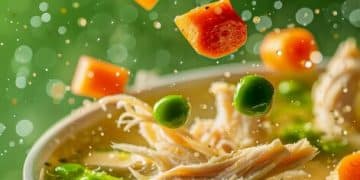Baby Food Allergies: Spotting Signs & Actionable Steps (Updated 2025)

Baby food allergies are adverse immune responses to proteins found in certain foods, and this guide provides updated information for 2025 on identifying symptoms, understanding common allergens, and taking appropriate steps to ensure your baby’s health and safety.
Navigating the introduction of solid foods to your baby can be an exciting but also nerve-wracking experience, particularly when considering the possibility of baby food allergies: spotting the signs and what to do next (updated 2025). Knowing what to look for can make all the difference.
Understanding Baby Food Allergies
Introducing solid foods to your baby is a significant milestone. However, it’s also a time when baby food allergies can become apparent. Understanding the basics of these allergies is essential for every parent.
What are Baby Food Allergies?
Food allergies in babies occur when their immune system mistakenly identifies a protein in food as harmful. This triggers an allergic reaction, which can range from mild to severe.
How Common are Baby Food Allergies?
Baby food allergies are relatively common, affecting around 6-8% of young children. While many outgrow these allergies, early identification and management are crucial.

Common Baby Food Allergens
- Cow’s Milk: Often found in formula and dairy products.
- Eggs: Commonly introduced in baked goods or as scrambled eggs.
- Peanuts: A highly allergenic food; consult your pediatrician before introducing.
- Tree Nuts: Includes almonds, walnuts, and cashews.
It’s important to introduce these foods one at a time to monitor for any allergic reactions. If your baby has a reaction, consult with a healthcare professional.
In conclusion, understanding the basics of baby food allergies, knowing how common they are, and being aware of the most common allergens can help you navigate this phase with confidence.
Recognizing the Signs of an Allergic Reaction
Recognizing the signs of an allergic reaction in your baby is critical for their safety. Reactions can vary, so being vigilant is key. Here’s what to look for:
Skin Reactions
Skin reactions are among the most common signs of a baby food allergy. These may include:
- Hives: Raised, itchy bumps on the skin.
- Eczema: Dry, itchy, and inflamed skin.
- Rashes: General redness and irritation of the skin.
Digestive Issues
Digestive problems are also indicative of an allergic reaction. Watch out for:
- Vomiting: Forceful expulsion of stomach contents.
- Diarrhea: Frequent, loose stools.
- Gas and Bloating: Excessive discomfort and swelling in the abdomen.
Respiratory Symptoms
Respiratory symptoms can be more serious and require immediate attention. These include:
- Wheezing: A high-pitched whistling sound during breathing.
- Coughing: Persistent and unexplained coughing.
- Difficulty Breathing: Obvious signs of struggling to breathe.
Other Signs to Watch For
Besides the above, other signs of a baby food allergy include:
- Swelling: Swelling of the face, lips, or tongue.
- Irritability: Unexplained fussiness and discomfort.
- Refusal to Eat: Sudden aversion to previously enjoyed foods.
In sum, being vigilant for skin reactions, digestive issues, respiratory symptoms, and other signs will help you identify potential allergic reactions early, ensuring your baby’s well-being.
The 2025 Guide to Introducing Solid Foods Safely
Introducing solid foods is a key development stage, and doing it safely is paramount. The 2025 guidelines emphasize a cautious and informed approach to minimize the risk of baby food allergies.
When to Start Introducing Solids
Most pediatricians recommend starting solid foods around 6 months of age. Before this, breast milk or formula should be the primary source of nutrition.
The Single-Ingredient Approach
When introducing solids, start with single-ingredient foods. This makes it easier to identify potential allergens. Wait 3-5 days before introducing another new food.
Recommended First Foods
Good starting foods include:
- Pureed Fruits: Such as bananas, avocados, and cooked apples.
- Pureed Vegetables: Like sweet potatoes, carrots, and green beans.
- Single-Grain Cereals: Iron-fortified rice cereal or oatmeal.
Foods to Avoid Early On
Certain foods are best avoided early in the introduction phase due to their allergenic potential:
- Honey: Not recommended for infants under 1 year due to the risk of botulism.
- Cow’s Milk: Can be difficult for babies to digest.
- Nuts and Seeds: Introduce cautiously and in age-appropriate forms.

How to Monitor for Reactions
After introducing a new food, monitor your baby for any signs of an allergic reaction. Keep a food journal to track what your baby eats and any reactions that occur.
In conclusion, knowing when to start, using the single-ingredient approach, understanding which foods to start with and avoid, and diligently monitoring for reactions are key steps in safely introducing solid foods, minimizing the risk of baby food allergies.
What to Do If You Suspect a Food Allergy
If you suspect your baby has a food allergy, it’s essential to take prompt action. This includes recognizing the signs, consulting with healthcare professionals, and implementing necessary dietary changes.
Stop Feeding the Suspected Allergen
Immediately stop feeding your baby the food you suspect is causing the allergic reaction. This can help prevent further symptoms.
Document the Reaction
Take detailed notes about the reaction, including:
- Symptoms: What you observed (e.g., hives, vomiting).
- Timing: When the reaction occurred after eating the food.
- Severity: How severe the symptoms were.
Consult a Healthcare Professional
Contact your pediatrician or an allergist. They can help diagnose the allergy and recommend a treatment plan. In severe cases, seek immediate medical attention.
Allergy Testing
Your healthcare provider may recommend allergy testing. Common tests include:
- Skin Prick Test: A small amount of allergen is applied to the skin to see if a reaction occurs.
- Blood Test: Measures the amount of allergen-specific antibodies in the blood.
Create an Allergy Action Plan
If your baby is diagnosed with a food allergy, create an allergy action plan with your healthcare provider. This plan should include:
- Foods to Avoid: A list of all allergens your baby needs to avoid.
- Emergency Contacts: Numbers to call in case of a severe reaction.
- Medication: Instructions for using medications like antihistamines or epinephrine (EpiPen).
In summary, if you suspect a baby food allergy, stop feeding the allergen, document the reaction, consult a healthcare professional, consider allergy testing, and create an allergy action plan to ensure your baby’s safety.
Managing Baby Food Allergies in 2025
Managing baby food allergies in 2025 involves a combination of dietary adjustments, vigilance, and staying informed about the latest advancements in allergy management.
Dietary Adjustments
The primary management strategy is to strictly avoid the allergenic food. This requires careful label reading and meal planning.
Breastfeeding and Allergies
If you are breastfeeding, continue to do so. Breast milk provides important immunological benefits. If your baby has a cow’s milk allergy, you may need to eliminate dairy from your diet.
Formula Alternatives
For formula-fed babies, hypoallergenic formulas are available. These formulas contain proteins that are broken down to reduce the risk of allergic reactions.
Label Reading
Always read food labels carefully. Allergens can be hidden in unexpected places. Look for advisory statements such as “may contain” or “processed in a facility that also processes.”
Preventing Cross-Contamination
Prevent cross-contamination by using separate cutting boards, utensils, and cookware when preparing food for your allergic baby.
Staying Informed
Stay updated on the latest research and guidelines for managing baby food allergies. Consult with your healthcare provider regularly to adjust your management plan as needed.
In conclusion, effective management of baby food allergies relies on dietary adjustments, breastfeeding support, formula alternatives, careful label reading, preventing cross-contamination, and staying informed about the latest advancements.
Future Trends in Baby Food Allergy Management
The field of baby food allergy management is continually evolving. By 2025, several promising trends and advancements are expected to shape how we approach and handle these allergies.
Oral Immunotherapy (OIT)
Oral immunotherapy involves gradually introducing small amounts of the allergenic food to desensitize the immune system. While still under investigation, OIT shows promise for some allergies.
Advancements in Allergy Testing
New, more accurate allergy tests are being developed. These tests aim to provide more reliable diagnoses and better predict the severity of allergic reactions.
Personalized Nutrition
Personalized nutrition plans, tailored to your baby’s specific allergenic profile, may become more common. These plans can help optimize nutrition while minimizing the risk of allergic reactions.
Education and Awareness
Increased education and awareness campaigns are helping parents better understand and manage baby food allergies. This includes resources for safe food introduction and emergency preparedness.
Research on the Gut Microbiome
Research into the role of the gut microbiome in allergy development is ongoing. Modifying the gut microbiome could potentially prevent or reduce the severity of food allergies.
In short, future trends in baby food allergy management include oral immunotherapy, advanced allergy testing, personalized nutrition, increased education, and research into the gut microbiome, all aimed at improving outcomes for allergic babies.
| Key Point | Brief Description |
|---|---|
| 🚨 Spotting Signs | Recognize skin reactions, digestive issues, and respiratory symptoms. |
| 🍎 Safe Introduction | Introduce single-ingredient foods, monitor reactions, and avoid honey early on. |
| 🩺 What to Do | Stop feeding suspected allergens, document reactions, and consult a healthcare professional. |
| 🔬 Future Trends | OIT, advanced testing, personalized nutrition, and microbiome research are promising. |
Frequently Asked Questions (FAQ)
The most common baby food allergens include cow’s milk, eggs, peanuts, tree nuts, soy, wheat, fish, and shellfish. It’s important to introduce these one at a time to monitor for reactions.
Signs of an allergic reaction can include skin reactions (hives, eczema), digestive issues (vomiting, diarrhea), respiratory symptoms (wheezing, coughing), and swelling of the face or lips. Consult your pediatrician immediately.
Stop feeding your baby the suspected allergen and document the reaction. Contact your pediatrician for advice on testing and management. In severe cases, seek immediate medical attention.
Most pediatricians recommend starting solid foods around 6 months of age. Ensure your baby can sit up with support and has good head control before introducing solids.
Advancements include ongoing research into oral immunotherapy (OIT), more accurate allergy tests, and personalized nutrition plans to better manage and potentially desensitize babies to food allergens.
Conclusion
In conclusion, understanding baby food allergies, recognizing the signs, and taking proactive steps are essential for your baby’s health. By staying informed and working closely with healthcare professionals, you can confidently navigate the introduction of solid foods and ensure a safe and healthy start for your little one.





